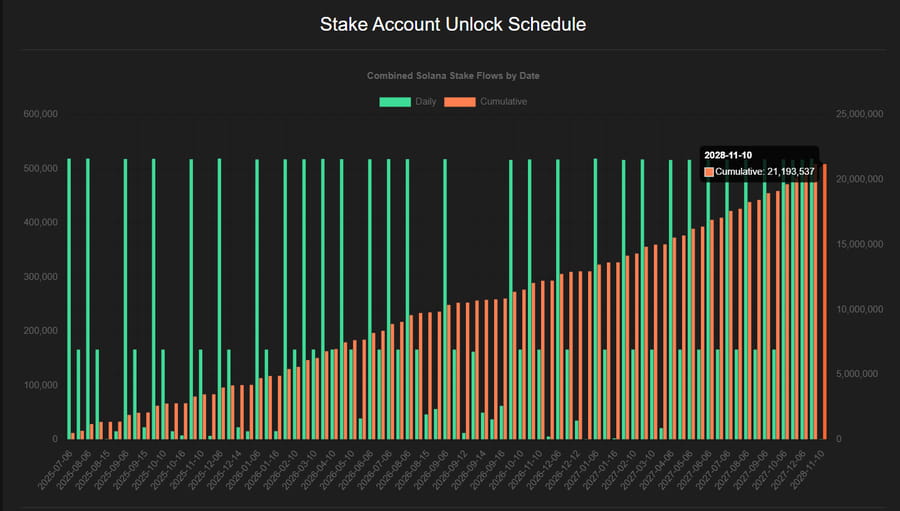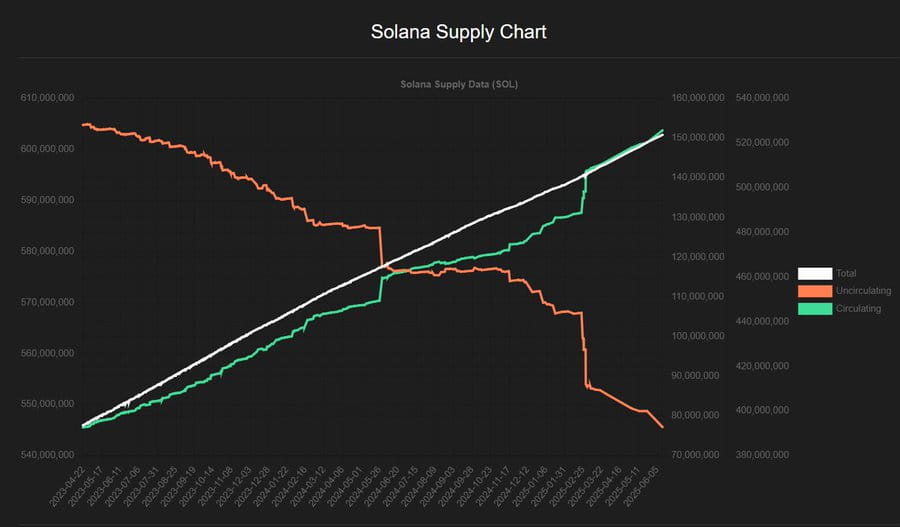Author: Nom
Translation: Deep Tide TechFlow
TL;DR
-The efficiency of SOL's digital asset treasury (DAT) in accumulating current trading supply will be better than that of ETH or BTC's DAT.
-The recently announced $2.5 billion scale SOL DAT is equivalent to $30 billion financing for ETH or $91 billion financing for BTC.
-SOL in the FTX legacy is about to exit the market, but its narrative impact still needs further digestion.
-The inflation issue of SOL remains an obstacle to price increases, with its scale about three times that of the unlocking amount, and needs to be resolved as soon as possible.
Do you really want to read the full content? Then let's first look at a few key points:
I won't discuss whether inflation is good or bad because I've already spent enough time on this, and I look forward to the upcoming changes.
I am a holder of spot SOL, staked SOL, and locked SOL (thanks to SPV on Estate SOL), so my perspective may be biased. I hope the tokens I hold appreciate, and stagnant prices are negative for me.
Downside: FTX legacy and market pressure
Like many blockchains you are familiar with, Solana sells tokens to investors through multiple rounds of financing. A large number of tokens flowed to FTX. According to @CoinDesk's @realDannyNelson, FTX held 41 million SOL at the time of its bankruptcy, most of which were sold through several rounds of financing, with major buyers including Galaxy and Pantera, at exercise prices of about $64 and $102 (plus related fees). At the current price of about $190 for SOL, these investments have made significant profits.
By analyzing the staking accounts, the 'FTX legacy SOL' currently has about 5 million units remaining to be unlocked, with a total value of about $1 billion.
Why mention this?
Recently, Galaxy and Pantera announced SOL DAT plans of $1.25 billion and $1 billion respectively, plus Sol Markets' $400 million, totaling about $2.5 billion (excluding related fees). The question is whether this will have a substantial impact on Solana's price, as the SOL locked in the market can be purchased or allocated by these entities. According to data from @4shpool(gelato.sh), there are still about 21 million SOL units to be unlocked until 2028, with a total value of about $4 billion. Rough calculations (more detailed model analysis can be provided by professional financial analysts) show that 'FTX legacy SOL' accounts for about a quarter of the remaining unlocking amount.

On the other hand, Solana's inflation issue is also worth noting. The current inflation rate is typically considered to be 7-8%, but the actual inflation rate is about 4.5% of the circulating supply. This means that if the supply of about 608 million SOL in the 839th cycle is calculated, the supply will increase by about 27.5 million (inflation) and 10 million (unlocking) after a year, bringing the total circulating supply to about 645.5 million, with an inflation rate of about 6.2%. Again, this is just a paper calculation, and I will let more experienced analysts take a look and provide you with more accurate charts.

The sharp increase in circulating supply shows that the 'static' inflation rate is not accurate; it can increase significantly at certain points in time and be smaller at others. We have completed the remaining major unlocking time points.
We need to focus on a key number: the amount of SOL entering the market daily. If someone receives tokens for free (e.g., through staking inflation or unlocking) or at a discount (e.g., FTX legacy SOL), it can be expected that a portion of it will be sold. I assume that the inflation amount of 37.5 million SOL in the coming year will all be sold. If I want the price to rise, this is bad news for me—see point 2. Therefore, we need capital inflows, which can be achieved through DAT or ETFs (e.g., $SSK) (thanks to the @REXShares team for creating and submitting the BONK ETF, which I unabashedly recommend). Ideally, every dollar used to buy SOL should enter the market to drive the price up. However, when SOL can be purchased at locked or discounted prices, this method is less efficient. Therefore, we assume that greedy DAT actors will buy these tokens before unlocking.
Is that bad?
In short: it's not bad. To offset the annual supply of 37.5 million SOL (assuming a price of $200 per SOL, idealized expectations), the market needs about $7.5 billion in capital inflows, or about $20.5 million per day (this is simplified and does not consider trading days from Monday to Friday and bank holidays). If DAT can purchase tokens at discounted prices from FTX legacy SOL or other locked SOL areas, it will enhance the efficiency of capital inflows.
For example, raising $400 million to purchase SOL at a 5% discount is equivalent to $420 million in capital inflows, which is clearly better than directly injecting $400 million into the market. The only question is how to evaluate the time value of purchasing SOL from the market today versus reducing sales in the future.
The inflation rate of SOL in the next three years will be higher than the unlocking amount (until the locking plan ends in 2028), and the FTX legacy SOL only accounts for a quarter of the remaining unlocking amount. Therefore, the priority of DAT to purchase legacy SOL rather than SOL on the market will not have a significant impact on the overall market. Either Galaxy or Pantera can clear the remaining supply (assuming all legacy SOL are for sale), not to mention existing DATs such as @defidevcorp, @solstrategies_, or @UpexiTreasury (as well as existing ETPs).
Good news: Trading supply vs. circulating supply
Spending on SOL is more efficient than spending on ETH or BTC for two main reasons.
Trading supply
First, circulating supply does not equal the tradable supply in the market, especially for staked assets. Staked SOL cannot be purchased directly, but staking token derivatives (LSTs) can be purchased. According to data from the @solscanofficial team, Solana currently has 608 million SOL, of which 384 million SOL have been staked, accounting for 63.1%. LSTs account for 33.5 million SOL, so the actual tradable supply in the market is about 57.5% (about 350 million SOL are non-tradable, with at least a two-day delay). In contrast, the staking ratio of ETH is 29.6%, and LSTs account for 11.9%. The higher supply in the market makes price fluctuations harder to achieve, while the lower trading supply of SOL helps to increase prices.
Relative capital efficiency
Solana's market capitalization is far less than ETH and BTC, with a circulating market cap of about $104 billion, while ETH is $540 billion and BTC is $2.19 trillion. Therefore, every dollar invested in SOL DAT is equivalent to five times the effectiveness of investing in ETH DAT and 22 times that of BTC DAT. When considering staked supply, this efficiency increases to 11 times and 36 times respectively.
The benefit of these DATs is that they remove supply from the market, earn tokens through staking rewards (already accounted for in the above inflation), and make subsequent tools like ETFs more effective in driving the market. Since its launch, SSK has had about $2 million in daily inflows, but the inflation plan requires 10 times the inflow—this could be achieved with the approval of more ETFs.
Why read this content?
I have never registered for Elon bucks, so this is a mystery for all of us.
Summary:
-Compared to ETH or BTC DAT, SOL DAT will be more effective in accumulating the current trading supply (rather than circulating supply). Currently, less than 1% of the supply is managed by SOL DAT, and this proportion is expected to increase to 3% with the launch of new plans, potentially reaching 5% in the future.
-The recently announced $2.5 billion scale SOL DAT is equivalent to $30 billion financing for ETH or $91 billion financing for BTC. SOL DAT needs a leading figure like Michael Saylor or Tom Lee to drive the narrative.
-SOL in the FTX legacy is about to exit the market, but its narrative impact still needs further digestion.
-The inflation issue of SOL still needs to be resolved, its scale is about three times the unlocking amount.
-Current ETF inflows are insufficient, but as larger-scale financial instruments are approved, SOL is expected to become a focus for institutions starting in Q4.
-Buy $BONK (not investment advice, do your own research).
-If you just want to get investment advice from posts like this, I suggest you find a more professional quantitative analyst to manage your assets.




